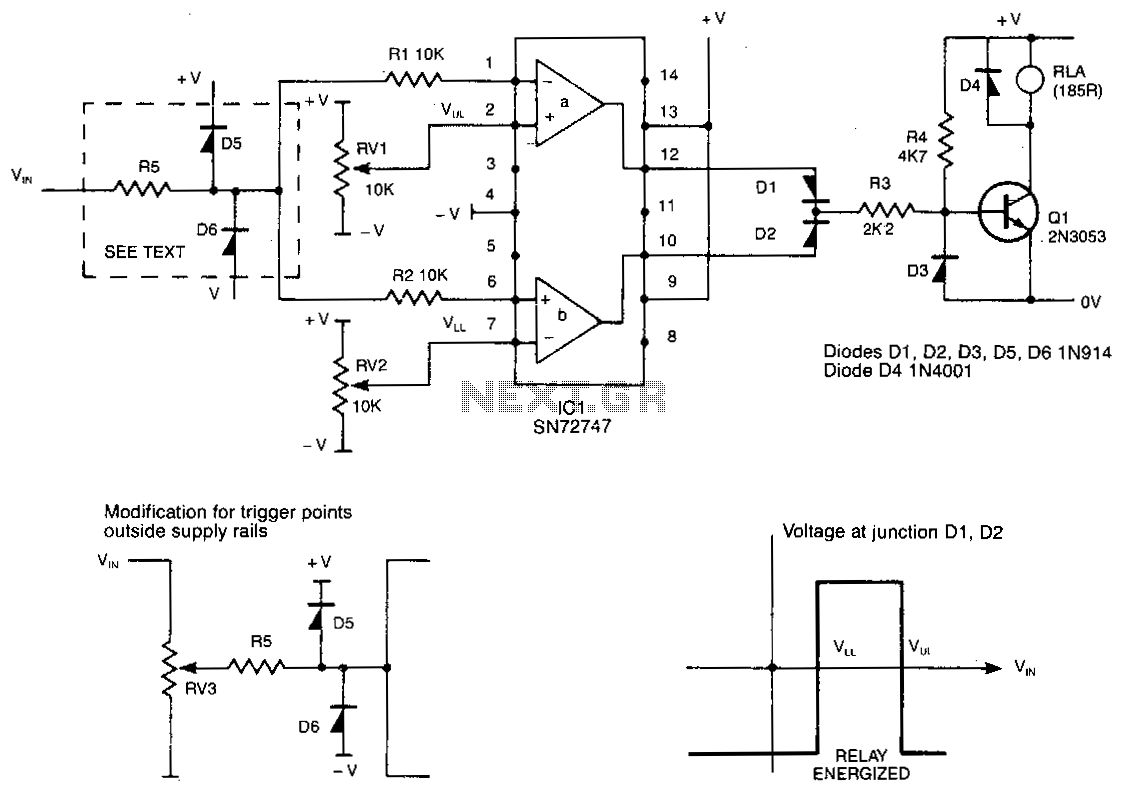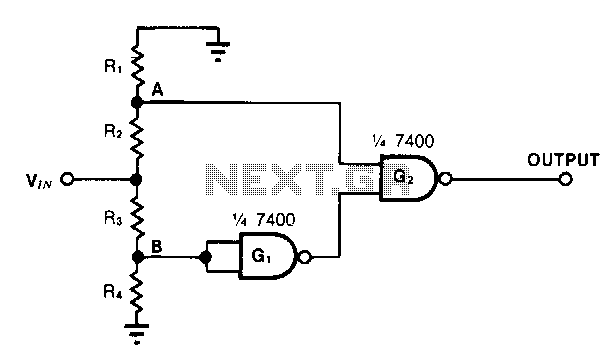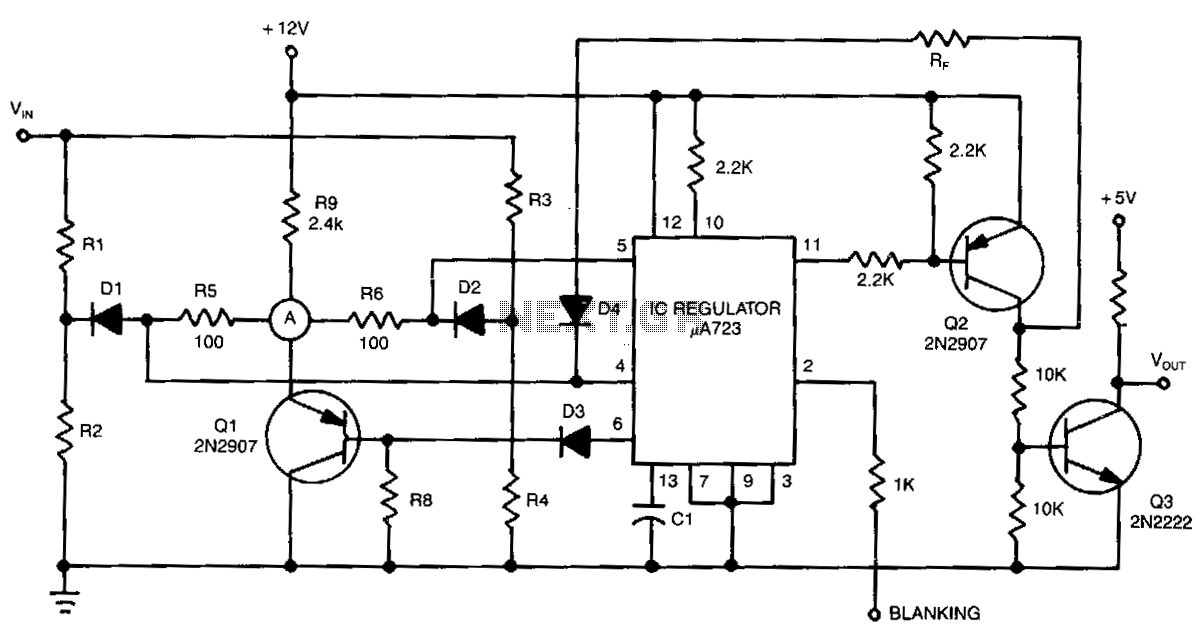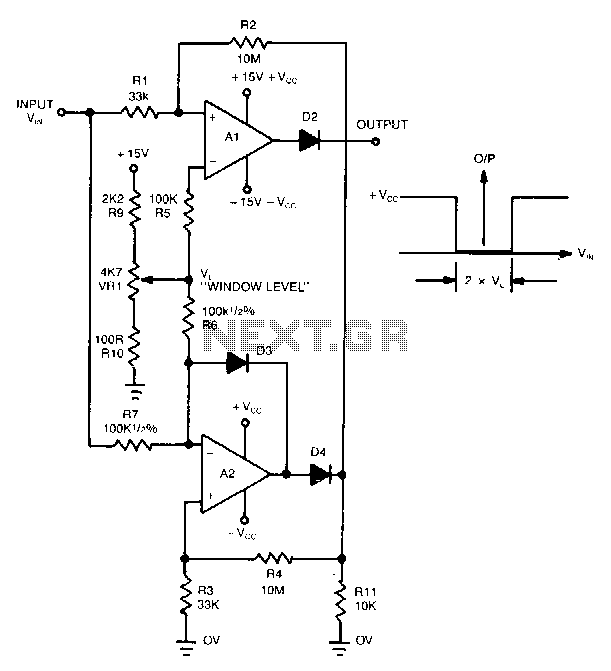
Window-detector

This circuit de-energizes a normally energized relay if the input voltage exceeds or falls below two individually set voltages. The transistor driving the relay is typically activated by resistor R4, keeping the relay energized. If the cathode of diodes D1 or D2 becomes negative, transistor Q1 will turn off, causing the relay to de-energize. The integrated circuit is a 72747 dual operational amplifier used without feedback, allowing for a full gain of approximately 100 dB. Consequently, the amplifier output can swing from maximum positive to maximum negative with only a few millivolts of input change. The relay remains energized only if the input voltage (VIN) is between the upper limit voltage (VUL) and the lower limit voltage (VLL). These two limits can be set anywhere within the supply rails, but it is essential that VUL is more positive than VLL. If VIN is expected to exceed the supply rails, diodes D5, D6, and resistor R5 should be included to protect the integrated circuit. If VUL and VLL need to be outside the supply rails, VIN can be adjusted downward using variable resistor RV3. The power supply can be any value, provided that the voltage difference between them does not exceed 30 V.
This circuit is designed to monitor an input voltage and control a relay based on specific voltage thresholds. The core component, a 72747 dual op-amp, operates in an open-loop configuration, providing high gain to detect small variations in input voltage. The relay is activated under normal conditions when the input voltage is within the defined range, ensuring that the system remains operational. The use of diodes D1 and D2 serves as a protective mechanism against negative voltage excursions that could inadvertently turn off the transistor Q1, leading to relay deactivation.
The circuit's flexibility allows for customization of the voltage thresholds through external resistors, enabling the user to define the operational parameters according to specific application requirements. The inclusion of protection elements such as diodes D5 and D6 ensures that the integrated circuit remains safeguarded against voltage spikes or negative voltages that could potentially damage it. This makes the circuit robust and reliable for various applications where monitoring and controlling relay states based on voltage levels is essential.
Furthermore, the design allows for the adjustment of input voltage levels through the use of RV3, accommodating scenarios where the desired threshold voltages exceed the supply voltage limits. The overall design is efficient, allowing for a wide range of input voltages while maintaining the integrity and functionality of the relay control system. The circuit's maximum supply voltage rating of 30 V ensures compatibility with standard power supply configurations, making it suitable for integration into various electronic systems.This circuit de-energizes a normally energized relay if the input voltage goes above or below two individually set voltages. The transistor driving the relay is normally turned on by R4, so the relay is normally energized. Ifthe cathode of Dl or D2 is taken negative, Ql will turn off and the relay will de-energize. The IC is a 72747 dual op amp used without feedback, so the full gain of about lOOdB is available. The amplifier output will thus swing from full positive to full· negative for a few m V change at the input.
The relay is therefore only energized if llN is between VUL and VLL. The two limits can be set anywhere between the supply rails, but obviously VuL must be more positive than "LL. If Vrn can go outside the supply rails, DS, D6, and RS should be added to prevent damage to IC1. If VuL and "LL are required to be outside the supply rails, llN can be reduced by RV3. The supplies can be any value, providing that the voltage across them is not more than 30 V. 🔗 External reference
This circuit is designed to monitor an input voltage and control a relay based on specific voltage thresholds. The core component, a 72747 dual op-amp, operates in an open-loop configuration, providing high gain to detect small variations in input voltage. The relay is activated under normal conditions when the input voltage is within the defined range, ensuring that the system remains operational. The use of diodes D1 and D2 serves as a protective mechanism against negative voltage excursions that could inadvertently turn off the transistor Q1, leading to relay deactivation.
The circuit's flexibility allows for customization of the voltage thresholds through external resistors, enabling the user to define the operational parameters according to specific application requirements. The inclusion of protection elements such as diodes D5 and D6 ensures that the integrated circuit remains safeguarded against voltage spikes or negative voltages that could potentially damage it. This makes the circuit robust and reliable for various applications where monitoring and controlling relay states based on voltage levels is essential.
Furthermore, the design allows for the adjustment of input voltage levels through the use of RV3, accommodating scenarios where the desired threshold voltages exceed the supply voltage limits. The overall design is efficient, allowing for a wide range of input voltages while maintaining the integrity and functionality of the relay control system. The circuit's maximum supply voltage rating of 30 V ensures compatibility with standard power supply configurations, making it suitable for integration into various electronic systems.This circuit de-energizes a normally energized relay if the input voltage goes above or below two individually set voltages. The transistor driving the relay is normally turned on by R4, so the relay is normally energized. Ifthe cathode of Dl or D2 is taken negative, Ql will turn off and the relay will de-energize. The IC is a 72747 dual op amp used without feedback, so the full gain of about lOOdB is available. The amplifier output will thus swing from full positive to full· negative for a few m V change at the input.
The relay is therefore only energized if llN is between VUL and VLL. The two limits can be set anywhere between the supply rails, but obviously VuL must be more positive than "LL. If Vrn can go outside the supply rails, DS, D6, and RS should be added to prevent damage to IC1. If VuL and "LL are required to be outside the supply rails, llN can be reduced by RV3. The supplies can be any value, providing that the voltage across them is not more than 30 V. 🔗 External reference


